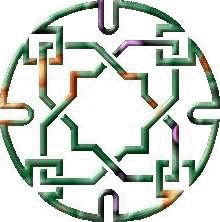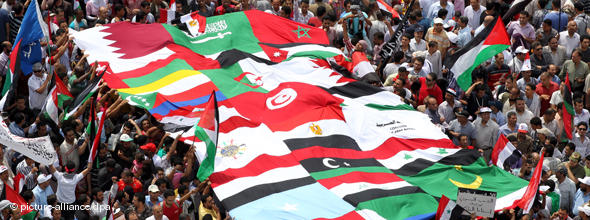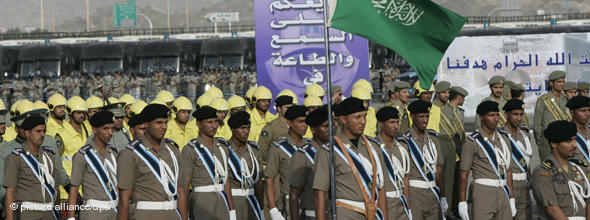



For decades, the Arab world stagnated under authoritarianism despite a global expansion of democracy beyond its historic core in North America and Western Europe. According to the US think tank Freedom House, the number of democracies in the world more than doubled by the new millennium, as communism collapsed and strongmen from Latin America to Southeast Asia were forced from power.
Although the Middle East appeared immune to this liberalizing trend, popular uprisings now referred to as the "Arab Spring" have successfully forced authoritarian regimes from power in Tunisia and Egypt, demonstrating that even political heavyweights like former Egyptian president Hosni Mubarak are ultimately accountable to the people.
"We're seeing in a sense the global spread of the aspirations for democracy finally coming to the surface in the Arab world," Jack Goldstone, an expert on revolutions with George Mason University in Arlington, Virginia, told Deutsche Welle.
But turning an uprising against an authoritarian leader into a broader revolution that brings true political change is more difficult. Although the regimes in Egypt and Tunisia have been successfully ousted, the future is uncertain. And in Libya, Syria and Yemen, peaceful calls for civil rights have descended into violence.
"Whether this results in revolutions or not depends on the local regimes," Goldstone said.
Liberal revolution
According to Goldstone, there are radical revolutions and liberal revolutions. Radical revolutions mobilize peasants and workers against upper classes as in the cases of France, Russia and China, resulting in a period of extremism and violence.
Liberal revolutions, however, are a nationalist mobilization of the people led by urban professionals with the aim of replacing an authoritarian ruler with a more democratic system.
"They have a different pattern because instead of the violent pursuit of internal enemies and a phase of terror and radical transformation, these revolutions focused more on the political, on trying to extend some liberal rights," Goldstone said.
 Bildunterschrift:
The uprising that began in Tunisia has spread across the Arab
world
Bildunterschrift:
The uprising that began in Tunisia has spread across the Arab
world
Goldstone says these liberal uprisings have become increasingly common and are exemplified by the so-called color revolutions of the opening decade of the new millennium. Based on a model of peaceful civil disobedience, protesters in the "Orange Revolution" in Ukraine and the "Rose Revolution" in Georgia called for more democratic government.
Goldstone believes a similar liberal model is now spreading across the Arab world after the "Jasmine Revolution" successfully toppled former president Zine el-Abidine Ben Ali in Tunisia, inspiring Egyptians to take to the streets and ultimately oust Hosni Mubarak.
"We saw these two elderly out of touch dictatorships swept from power, probably surprised by the fragility and narrowness of their social base," Kristian Coates Ulrichsen, an expert on Arab politics with the London School of Economics, told Deutsche Welle.
"They were just so shocked at what was happening that they just tried their old methods of repression and cracking down, and when it didn't work they had no plan B."
Organizing the masses
Although the protesters managed to carry out a successful uprising by focusing all of their pressure on the personalities of Ben Ali and Mubarak, Ulrichsen says the leaderless masses who took to the streets are now having trouble articulating their aims and turning their uprising into real political change - a revolution.
"That's much easier isn't it - to be against something rather than for it," Ulrichsen said. "They've had trouble everywhere in defining what they're for and trying to create a coherent platform to express the demands they want."
Goldstone explains the current phase of uncertainty as "competitive mobilization." The different groups who participated in the uprising are now mobilizing to compete with each other for power and leadership in the new political system.
"It's a process that, unfortunately, produces some instability and weak government rather than strong and decisive government," Goldstone said.
"But in a sense it's a better tradeoff, because strong and decisive government usually means a return to authoritarianism and a loss of that democratic freedom."
Fragile transition
This period of political uncertainty, however, carries risks. Although Ben Ali and Mubarak are gone, much of the old system still remains in place. Egypt's political transition is being administered by the Supreme Council of the Armed Forces, which has come under growing criticism for trying civilians in military courts.
"It is still possible that it's only a change of personnel in the top of the regime and all the structures will remain the same," Henner Fürtig, an expert on political transformation in the Middle East with the German Institute for Global and Area Studies in Hamburg, told Deutsche Welle.
 Bildunterschrift:
Großansicht des Bildes mit der Bildunterschrift:
The Egyptian military is overseeing
the political transition
Bildunterschrift:
Großansicht des Bildes mit der Bildunterschrift:
The Egyptian military is overseeing
the political transition
According to Fürtig, in Egypt the old regime had three core pillars of power: Mubarak's National Democratic Party, the public sector and - most importantly - the military.
"The military is still in charge," Fürtig said. "We have to wait until the elections in September and especially until the presidential elections next January. How will the military behave if a candidate will be elected who is not the real choice of the military? Then everything is open again."
Butterfly effect
Fürtig remains reluctant to call the upheaval in the Arab world a revolution due to the uncertainty in countries like Egypt and Tunisia. The Arab nations, however, share the same underlying problems of authoritarian government, bulging youth populations and high unemployment. As a consequence, Fürtig believes that every Arab regime at least faces the possibility of succumbing to a popular uprising.
"If it is a revolution it will be a revolution of the entire region and not only of one or two countries," Fürtig said.
Fürtig breaks the Arab Spring down into three classes of states. He says Egypt and Tunisia have the best chance of becoming pluralistic democracies. Meanwhile, Libya, Syria and Yemen have unclear futures due to the on-going violence in those countries. The Sunni monarchies - Morocco, Jordan, Saudi Arabia and the Gulf states - appear to be more resilient to demands for political change.
According to Fürtig, these nations all influence each other, but the impact tends to be indirect. Successful change in Tunisia, for example, could have an effect on far-away Saudi Arabia, but it will take a long time to play out.
"Let's be frank - it will not be a domino effect," he said. "If you try to paint it in pictures, it's not a domino effect - it's a butterfly effect. It has its effects but not direct ones, not immediate ones."
Counterrevolution
As Egypt and Tunisia undergo political transition and Libya, Syria and Yemen face civil war, the Sunni monarchies are rallying to hold the line against the spread of a liberal revolution throughout the broader region.
When protesters took to the streets in the tiny Gulf kingdom of Bahrain, Saudi Arabia intervened militarily to prevent the fall of its neighboring royal family. Since then, the Sunni monarchies have increased their cooperation and even invited Morocco and Jordan to join the Gulf Cooperation Council (GCC), an economic and security organization once exclusive to the Gulf states.
"Saudi Arabia is projecting itself as the lynchpin of this monarchical conservative status quo block against Egypt, Iran and other states in the region that it now views as risky," Ulrichsen said.
 Bildunterschrift:
Saudi Arabia and other Gulf states intervened in Bahrain
Bildunterschrift:
Saudi Arabia and other Gulf states intervened in Bahrain
As the regional lynchpin, reform may have to begin in Saudi Arabia before it can truly take root in the neighboring Gulf nations.
"For Saudi Arabia's neighbors, yes, until something happens in Saudi Arabia the chances for any change are quite slim," Ulrichsen said.
Although the US and EU have tried to re-orient their foreign policies to side with the demonstrators, they are unlikely to put any kind of pressure on Saudi Arabia that runs the risk destabilizing the world's largest petroleum exporter. As a consequence, the "counterrevolution" against the Arab Spring led by the House of Saud in Riyadh is likely to continue.
Goldstone, however, believes that the popular uprisings will ultimately lead to varying degrees of political reform throughout the Arab world.
"What we're seeing in the Arab Spring is part of a global and historical trend toward people demanding their right to hold their governments accountable and this has spread globally," Goldstone said.
Author: Spencer Kimball
Editor: Rob Mudge